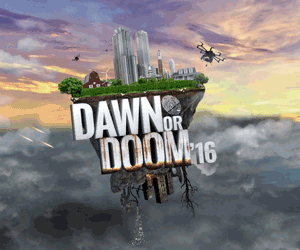October 4, 2016
Dawn or Doom '16: Future of AI requires learning how to learn when there are no rules

When Google's Alpha Go -- the artificial intelligence created to play the complex board game Go -- beat a professional player for the first time earlier this spring, it was heralded as a notable achievement for the AI field.
Less than a month later, when Tay -- Microsoft's AI chatbot -- was unleashed into the Twittersphere and subsequently began spouting racist and hateful speech, the result was a reminder of just how far the field of artificial intelligence has to go.
Jennifer Neville, associate professor and Miller Family Chair of Computer Science and Statistics, used those two events to highlight the difficulty that remains in creating truly intelligent artificial intelligence systems as part of her Dawn or Doom '16 presentation, "AI-Easy vs. AI-Hard," on Monday (Oct. 3). The conference on the risks and rewards of new technology continues today (Oct. 4) at Purdue's West Lafayette campus with presentations by speakers throughout the day and a closing keynote talk by author Dave Eggers at 6:30 p.m. in Stewart Center's Loeb Playhouse.
The difference between the success and failure of the two projects, Neville said, was the degree to which each were held to a set of rules, responses and defined goals. For the computer playing Go, the goal was simple: To follow the rules and win. But for the chatbot, the goal is less defined: How, after all, does a person define a successful conversation? And what, if any, are the rules?
Although programmers can map out the sequence of moves for a game, the process quickly outraces even a supercomputer's ability to compute all outcomes as games increase in complexity. For instance, a simple game like tic-tac-toe can have up to 100,000 possible sequences of moves. The game Go has more moves than four times the number of atoms in the universe, Neville said.
So creating a Go system that learns the best possible moves against a human player was an incredible achievement, Neville said, but it was made much easier because it was an achievement within a fixed system.
The harder challenge, she said, is figuring out ways for an AI to learn in a system where the rules are constantly changing and the goals are less defined -- as in a conversation.
"Language has structure and rules," Neville said, "but they're not clear-cut. And they are continually evolving and being broken. Unlike in a game, there are an infinite number of possible scenarios."
And sometimes the scenarios are hard to predict.
When Microsoft released Tay on Twitter, a coordinated troll attack began bombarding the chatbot with racist and hateful messages, resulting in the AI's learning those behaviors and language cues, which it then used to tweet inappropriate messages of its own, prompting Microsoft to deactivate the account.
"In a sense Tay had the language processing skills of a 7- or 8-year-old, who is still learning language and how to process the things other people say," Neville said. "The problem is, you don't let a 7-year-old out on Twitter. You send them first to somewhere safe and inviting, where they learn to process the world surrounded by love and kindness, like kindergarten."
Neville said the next big step for artificial intelligence development is to figure out how machines can learn to adapt and change in systems that aren't fixed, whether it's with chatbots or the computers behind the wheels of driverless cars.
"We need to learn how to learn from subtle, inconsistent, often delayed feedback," Neville said. "That's the challenge."
For more information about Dawn or Doom '16, which is free and open to the public, visit http://eventmobi.com/dawnordoom2016/.
Writer: Dave Stephens, 765-496-7998, steph103@purdue.edu
